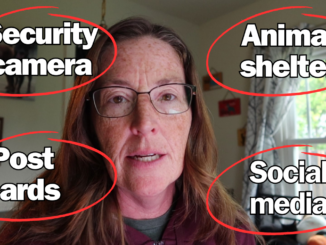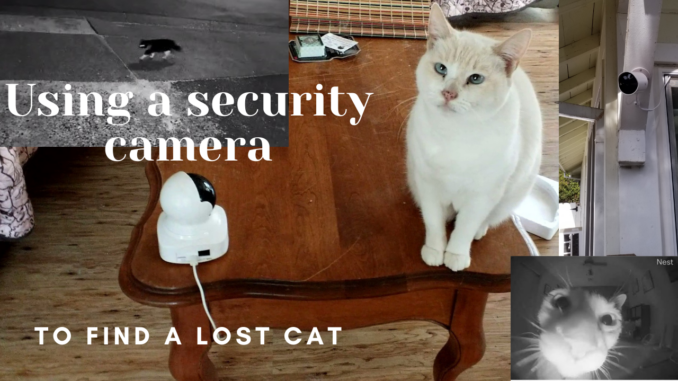
Did you know you can find a lost cat with a security camera? Learn how to choose a camera, set it up, and most effectively use it to locate your missing cat.
We all remember the days of old school security cameras. Most often used in banks and other businesses, they were clunky and provided such grainy footage that law enforcement could hardly tell who the robbers were. Early home systems weren’t much better, costing a fortune to purchase and install and providing similarly low quality footage.
Today, security cameras are inexpensive, easy to buy and set up, and they provide HD quality footage live to your phone! For these reasons, they make a great tool to help find your lost cat.
When to use a security camera
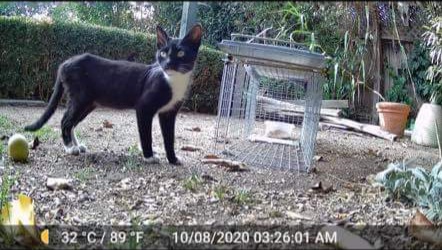
Proper use of any tool will increase its effectiveness. The security camera’s primary purpose is to verify the location of your kitty. You may want to use it when you are getting reported sightings, but don’t have a picture or haven’t seen your cat yourself to be sure. You may not be getting sightings, but there are places your cat is likely to be, such as near your front door, back porch, or a neighbor’s yard where they feed outside cats. Once you pinpoint your cat’s location, you can also determine the times he is active there and make a plan to capture him.
Choosing your camera
There are a variety of security cameras available with different price points and functionality. Which one you choose will depend on your budget and the area where you need to set it up.
Movable indoor camera
I really like the movable kind that can be controlled from an app on your phone. This kind of camera can just sit on its own base or be affixed to a table, wall, or other structure for increased stability. With this camera you can view a wide area remotely.

Because of the design, this camera is not weather proof and should be used indoors or in a protected area. You can place it inside a window looking out, or under a covered porch or other structure.
Hard wired outdoor camera
Hard wired outdoor cameras work well if you have a place to install and plug them in. I have one pointing out the front of my home so I can see anyone approaching the property. I just run the cord through the window and plug it in inside the house. These cameras provide good footage but aren’t movable, so you have to set them up to cover the whole area you want to view.

Cordless outdoor camera
Cordless units like Arlo are great for larger country properties and more remote areas. You can attach multiple cameras all around an area to get a comprehensive view. This kind of camera requires a base station that is plugged in and connected to wifi, but the cameras can be placed some distance from the unit. Check the manufacturer’s instructions for details.

Doorbell camera
Doorbell cameras like Ring are very popular. They serve multiple purposes and have broad functionality, with a price to match. If you can afford it, or if you need the other functions for your home, go for it. These products are high quality and should have a warranty if they don’t work properly or if you’re not happy with the service.

Such a camera will usually be installed into the outer wall of your house facing the front door or porch so the range is limited. However, an alternative to buying one yourself is to ask your neighbors to check footage from cameras they already have installed to see if your cat has passed by.
Purchase price varies, so shop around and look out for sales so you can get the camera you need within your budget. Be aware that these cameras also require a subscription to save recorded footage. Those prices vary as well. I only pay $9 a month for my service, but other companies may charge more (and offer more premium services).
How to set up
Unlike their older cousins the trail cameras which can be set up anywhere, security cameras need electricity and internet in order to work. If you are setting them up at home, this shouldn’t be a problem. If you are setting them up at another location, you may be able to use the power and internet at a neighbor’s home or a business. You can also use a mobile hotspot device any place there is a cellular connection.
This may sound obvious, but follow the instructions. Security cameras have a list of steps that must be followed in order or they won’t work properly. First you will need power. Plug the unit in, or if it has batteries make sure they are charged. Download the camera’s app on your phone and pair it with the device. You will need to have both the camera and your phone in your hands to do this, so make sure it’s all good before mounting the camera outside!
Place the camera where you want it. Depending on the style, it may be free-standing or bolted to a wall, fence post, or other sturdy structure. Watch the camera footage on your phone while you are installing, and before you drive in the final screw. Make sure it is taking in the area you want to observe. When I installed my outdoor camera, I moved it twice then spent some time adjusting the position to where I wanted it. It is difficult to imagine what the camera will “see” without looking at the footage.
Make sure the camera is secure. You don’t want it to blow out of position in the wind, fall and break, or come unplugged. Make sure it is bolted down tightly or placed out of harm’s way. If it is an indoor camera, make sure it is out of the elements or it will be damaged by moisture.
Location and Privacy
For maximum effectiveness, set up the camera where your cat has been seen or is likely to be. Some good spots are outside your front or back door, on a porch, or in your back yard. Sometimes cats are trying to get back in and will approach the house, but they are not seen by owners because they are active at odd hours, like 2 or 4 in the morning.
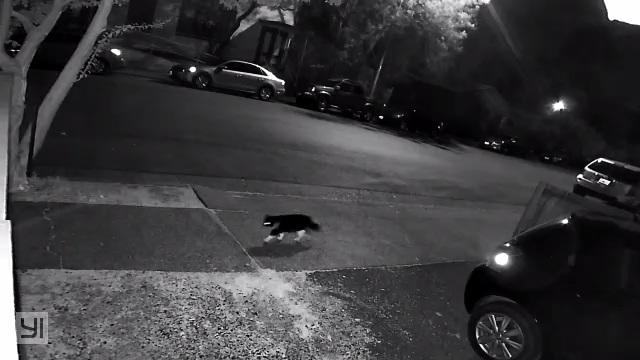
You may want to set up the camera in a neighbor’s yard or in front of their house, with permission of course. They may have reported a sighting near their home, or they may feed outside cats so their yard is likely to be attractive to a lost cat.
Communicate with neighbors and any others involved. If people see you walking around at night with a flashlight and setting up cameras, they may think you are planning a burglary or having a psychotic episode.
When positioning your cameras, use common sense and observe local laws regarding privacy. Don’t point the cameras at an area that could violate that privacy, such as inside another person’s home or yard. My camera faces a public street downtown so there is no expectation of privacy. Even so, I still would not share any image or video showing people walking by (unless I needed to report a crime to the police).
Theft and vandalism
Security cameras may be stolen or vandalized, so you should take steps to prevent this. It is best if they are out of sight or securely bolted to a structure. If they are in your back yard or porch, there is likely less concern as they won’t be seen by anyone, but if they are in front of your house or someone else’s house, you will want to be more cautious. If it does happen, at least you will have a video of the thief or vandal saved to the cloud!
The mobile hotspot device is more of a concern because it is so portable. If someone sees it, they can easily put it in their pocket and walk away. If using a mobile hotspot, lock it up or hide it very well.
You may want to put up a sign similar to what is recommended in the trapping article and video, depending on the location of your camera(s). Such a sign informs people of your intentions and may even help engage them in your search.
Apps and monitoring
Gone are the days of clunky VCR machines, tapes, and TV screens to view security camera footage. Today’s cameras are all managed by apps you can easily run on your phone or tablet from anywhere. You can check your cameras live from anywhere as well as view recorded footage. You can set the app to give you push notifications when motion is detected, and these notifications should show a snapshot of the motion so you can filter through footage you don’t need.
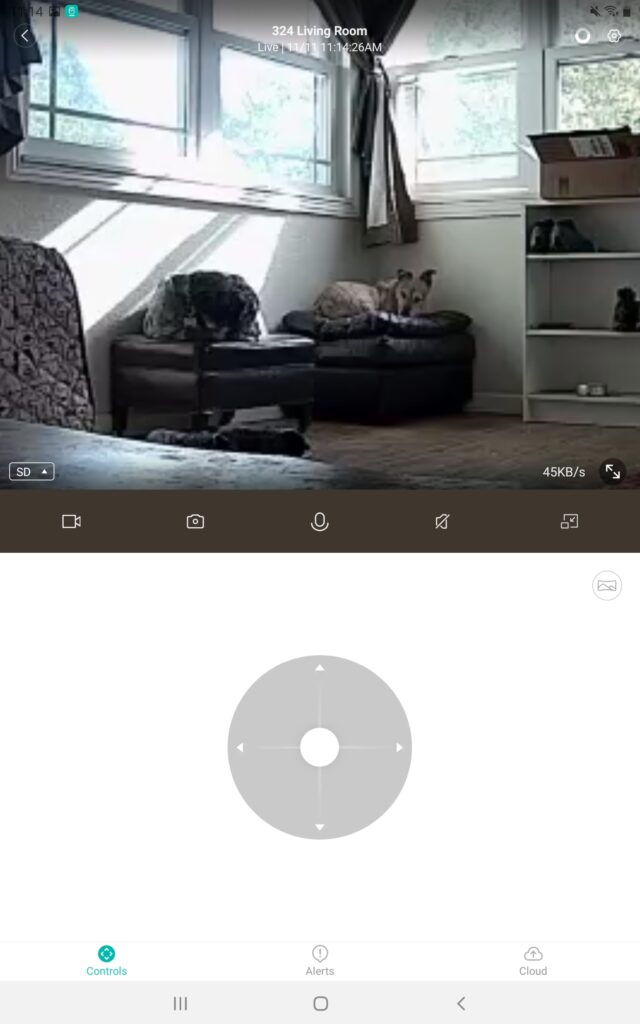
Some cameras can be moved via controls on the app so you can get a panoramic view of your search area. You can also set motion tracking so such a camera will follow the movement for maximum footage.
How it works and possible errors
The first thing to understand about cameras is that they aren’t people. You probably knew that. They “see” in a different way, so may not capture the footage you want without some tweaking. A typical camera will notify you when there is motion, but that may not be a person or animal walking by. “Motion” is seen as any change in light, so the shadows of trees in the wind or headlights from cars may trigger frequent and unwanted notifications.
On my own camera at home I had way too many recordings of cars passing by. I live in a downtown area so there is traffic all the time. I tried reducing the sensitivity but then I wasn’t getting footage of people and animals, so that didn’t work. I then set the tracking area (see photo) and that helped a lot by reducing notifications from the street. You’ll have to play with the settings on your camera for best results.
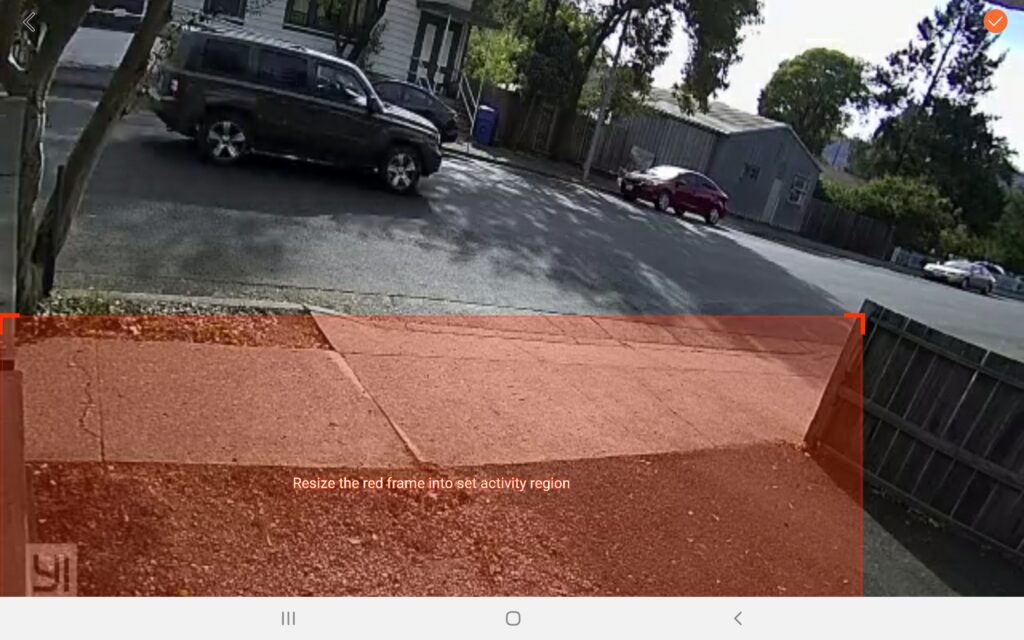
You’ve seen your cat! Now what?
The most important step when searching for your missing cat, whichever tool you are using, is to have a plan! I have seen too many cases where an owner is so excited to have spotted their cat (or dog) that they do everything wrong, from chasing after them to trying to put an unconfined cat into a car. This doesn’t end well, and if the cat is frightened and runs away it will make recovery even more difficult at the next opportunity.
Determine the time of sightings
Once you have confirmed footage of your kitty on video, determine the time of day or night he is coming around. Cats are pretty habitual so it will likely be at the same times. You can influence this by leaving food near the camera, but be aware that you may also attract other cats or wildlife that may hinder your search. Experiment and use your judgment.
Lure into the house
If your kitty is seen right outside your own home, you can leave a door or window open to lure him inside. Of course, you will have to take into consideration any other pets in the home as well as your own safety. You won’t want to leave the front door wide open if you live in the middle of town in plain view of many people.
Think about how your cat usually comes in the house. Front door, back door, window? Leave that open if it is safe to do so and leave some smelly food inside. Some cats are actually trying to get back into their homes but they can’t because the doors are closed and they are coming around at 3 or 4 in the morning when no one sees them.
Transport securely
If you think your cat will let you pick him up, go to the location where he is with a secure carrier. Take your time to coax him to you and into the carrier. Don’t chase or grab him suddenly, as you may be scratched or bitten. Even the most friendly cat can go wild when stressed and behave in a way they wouldn’t normally. Once in the carrier, bring your cat home and give him time to reacclimate.
If you aren’t able to get him in the house or in a carrier, a humane trap may be your best bet. Set it within view of the camera so you can respond immediately. Once he is in the trap, cover it and take him home. Do not try to take him out of the trap in an unsecured area.
Proper use of the security camera and other tools can help you bring your lost kitty home quickly and safely.


